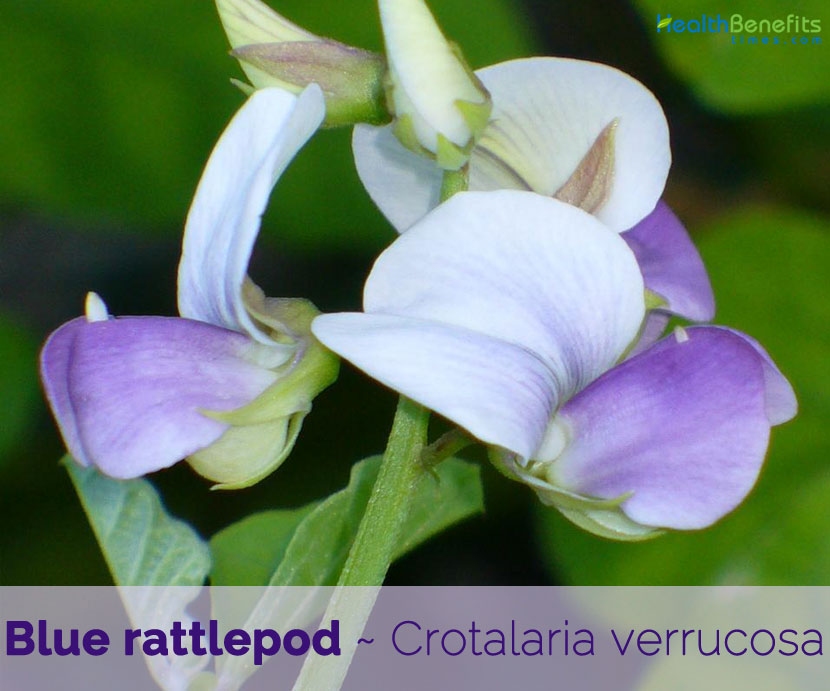| Blue rattlepod Quick Facts | |
|---|---|
| Name: | Blue rattlepod |
| Scientific Name: | Crotalaria verrucosa |
| Origin | Bangladesh, China, Cambodia, India, Indonesia, Laos, Malaysia, Myanmar, Nepal, Philippines, Sri Lanka, Thailand, Vietnam |
| Colors | Yellowish to brownish |
| Shapes | Oblong pod, 3–4 cm long, 9–12 mm thick, apressed pubescent or with spreading brown hairs |
| Taste | Bitter, astringent, sour |
| Health benefits | Beneficial for headaches, fever, stomach pains, dyspepsia, throat, mouth diseases, heart complaints, scabies, impetigo |
Plant Description
Blue rattlepod is an erect or spreading, much-branched, annual, sub-woody plant that grows about 50 to 100 cm in height. The plant is found growing in fallow fields, marshy ground, along rivers, roads, Grassland, sparse forests, edges, open places in dry evergreen and deciduous forests. Stem is 4-angled, sulcate, shortly appressed or spreading pubescent. Twigs are 3 or 4 winged. Stipules are foliaceous, falcate, about 12-38 mm long and 13-31 mm wide, apex acuminate. Leaf blades are about 6.5-15 cm long and 3.5-5.5 cm wide, petioles are about 0.4-1 cm long, upper and lower surfaces are clothed in short white hairs. Lateral veins are about 7-13 on each side of the midrib.
Flowers
Flowers are subtended by narrow lanceolate, about 9 mm long, bracts, apex inflated and hooked. Flowers about 16-18 x 23 mm. Calyx tube is about 3-4 mm long, lobes about 6 mm long. Stamens ten, filaments fused into a tube about 6-7 mm long, open on one side. Petals: standard about 16 x 12 mm, wings about 12-15 mm long, keel about 12-15 mm long. Stamens dimorphic, the longer filaments with small anthers about 0.8 x 0.8 mm and the shorter filaments with longer anthers about 4 x 1 mm. Ovary densely clothed in white hairs. Style about 8-9 mm, hairy towards the apex. Flowering normally takes place from November.
Fruit
Fertile flowers are followed by cylindrical pods, about 50-80 mm long and 10-16 mm wide, hairy, grooved on one side. Seeds are about 28-32 per fruit. Outer surface of the seeds and the inner surface of the pod are oily. Radicle is adjacent to the cotyledons.
- Leaf paste is applied to cure headaches.
- The roots are used as a treatment against fever and stomach pains.
- The plant is blood purifier, emmenogogue. It is used to purify the blood and to cure skin diseases.
- Roots are used against fever and stomach pain.
- The leaves are expectorant and emetic; cure biliousness, dyspepsia, fever, throat and mouth diseases and heart complaints.
- It is used both internally and externally for scabies and impetigo and in diminishing salivation.
- Leaf extract is applied to soothe skin allergies.
References:
https://www.itis.gov/servlet/SingleRpt/SingleRpt?search_topic=TSN&search_value=501811#null
http://www.hear.org/pier/species/crotalaria_verrucosa.htm
https://npgsweb.ars-grin.gov/gringlobal/taxonomydetail.aspx?id=12396
https://indiabiodiversity.org/species/show/229374
https://www.wikidata.org/wiki/Q10932824
https://wikivisually.com/wiki/Crotalaria_verrucosa
https://plants.usda.gov/core/profile?symbol=CRVE5
https://en.wikipedia.org/wiki/Crotalaria_verrucosa
http://www.plantsoftheworldonline.org/taxon/urn:lsid:ipni.org:names:489042-1
http://tropical.theferns.info/viewtropical.php?id=Crotalaria+verrucosa
https://uses.plantnet-project.org/en/Crotalaria_verrucosa_(PROSEA)
http://tropical.theferns.info/viewtropical.php?id=Crotalaria%20verrucosa
http://www.canbr.gov.au/cpbr/cd-keys/RFK7/key/RFK7/Media/Html/entities/Crotalaria_verrucosa.htm
Comments
comments
